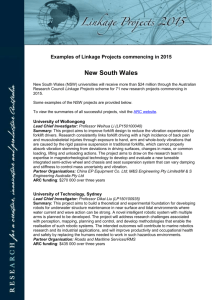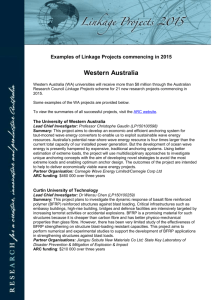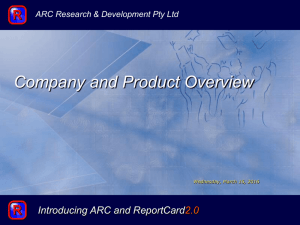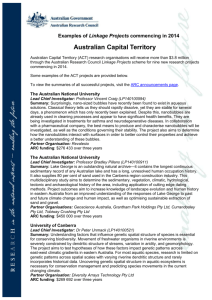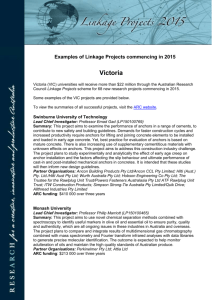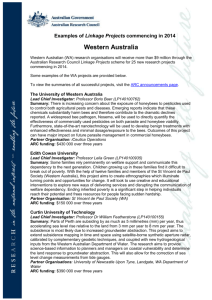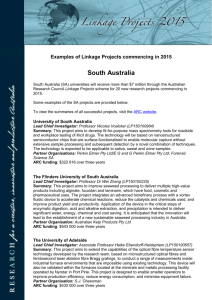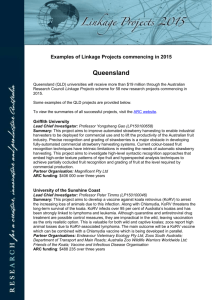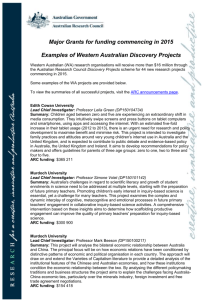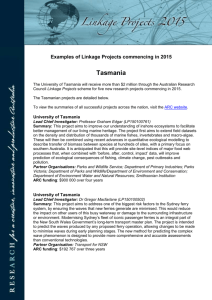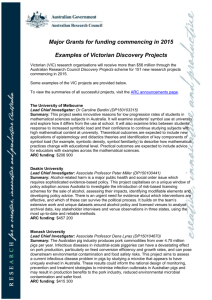Word Format - Australian Research Council
advertisement
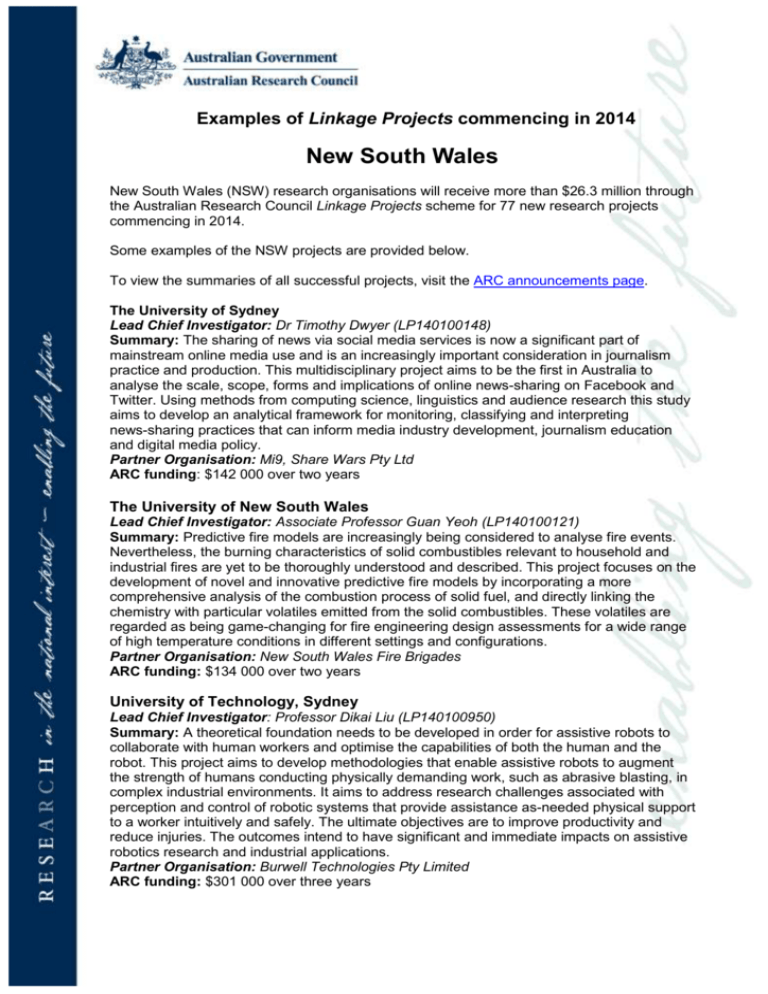
Examples of Linkage Projects commencing in 2014 New South Wales New South Wales (NSW) research organisations will receive more than $26.3 million through the Australian Research Council Linkage Projects scheme for 77 new research projects commencing in 2014. Some examples of the NSW projects are provided below. To view the summaries of all successful projects, visit the ARC announcements page. The University of Sydney Lead Chief Investigator: Dr Timothy Dwyer (LP140100148) Summary: The sharing of news via social media services is now a significant part of mainstream online media use and is an increasingly important consideration in journalism practice and production. This multidisciplinary project aims to be the first in Australia to analyse the scale, scope, forms and implications of online news-sharing on Facebook and Twitter. Using methods from computing science, linguistics and audience research this study aims to develop an analytical framework for monitoring, classifying and interpreting news-sharing practices that can inform media industry development, journalism education and digital media policy. Partner Organisation: Mi9, Share Wars Pty Ltd ARC funding: $142 000 over two years The University of New South Wales Lead Chief Investigator: Associate Professor Guan Yeoh (LP140100121) Summary: Predictive fire models are increasingly being considered to analyse fire events. Nevertheless, the burning characteristics of solid combustibles relevant to household and industrial fires are yet to be thoroughly understood and described. This project focuses on the development of novel and innovative predictive fire models by incorporating a more comprehensive analysis of the combustion process of solid fuel, and directly linking the chemistry with particular volatiles emitted from the solid combustibles. These volatiles are regarded as being game-changing for fire engineering design assessments for a wide range of high temperature conditions in different settings and configurations. Partner Organisation: New South Wales Fire Brigades ARC funding: $134 000 over two years University of Technology, Sydney Lead Chief Investigator: Professor Dikai Liu (LP140100950) Summary: A theoretical foundation needs to be developed in order for assistive robots to collaborate with human workers and optimise the capabilities of both the human and the robot. This project aims to develop methodologies that enable assistive robots to augment the strength of humans conducting physically demanding work, such as abrasive blasting, in complex industrial environments. It aims to address research challenges associated with perception and control of robotic systems that provide assistance as-needed physical support to a worker intuitively and safely. The ultimate objectives are to improve productivity and reduce injuries. The outcomes intend to have significant and immediate impacts on assistive robotics research and industrial applications. Partner Organisation: Burwell Technologies Pty Limited ARC funding: $301 000 over three years University of Western Sydney Lead Chief Investigator: Professor Rhonda Craven (LP140100481) Summary: Despite emphasis worldwide on enabling high-ability students to realise their potential, little is known about drivers that seed success in educational outcomes and wellbeing for high ability Aboriginal students who underachieve, are under identified and are underrepresented in selective settings. Capitalising on interdisciplinary theory and research, a powerful multi-method design and state-of-the-art statistics, the project aims to explicate psychosocial determinants of high-ability Aboriginal students' educational outcomes and wellbeing and test the efficacy of novel research-derived interventions. This aims to advance knowledge, policy and practice to enhance the provision of education to high-ability Aboriginal students ensuring they realise their full potential. Partner Organisation: NSW Department of Education and Communities ARC funding: $342 000 over three years University of Wollongong Lead Chief Investigator: Professor Buddhima Indraratna (LP140100065) Summary: Along Australia's coast, the abundance of soft clay often hampers the design and construction of transport infrastructure including embankments. The use of vacuum pressure and prefabricated vertical drains (PVD) ensures rapid drainage and consolidation of the clay, thus increasing its shear strength and bearing capacity while reducing long term deformation. The main aim of this project is to achieve technological advancement in sustainable and cost effective PVD-vacuum systems by minimising the time to achieve the desired degree of consolidation, thereby controlling post construction settlement and lateral movement. Extensive laboratory and field studies supported by numerical modelling aim to result in new industry guides and standards. Partner Organisations: Coffey Geotechnics Pty Ltd, National Jute Board, Douglas Partners Pty Ltd, Menard Bachy Pty Ltd, Soilwicks Australia ARC funding: $735 000 over three years Macquarie University Lead Chief Investigator: Associate Professor Culum Brown (LP140100319) Summary: Sharks are vital components of marine ecosystems and contribute significantly to ecotourism and fisheries. Due to their slow rate of growth and reproduction, sharks are susceptible to over exploitation. A lack of knowledge regarding their behaviour and movement patterns is a key impediment to effective management. This project aims to examine social interactions and migration patterns of Port Jackson sharks using a unique combination of genetic techniques, novel acoustic tag technology, behavioural manipulations and modern social network analysis. Once verified, the approach developed can be applied to other marine predators of particular management concern. The data generated will directly inform fisheries and conservation management policy. Partner Organisations: Sonotronics Inc, Taronga Conservation Society, NSW Fisheries, Bimini Biological Field Station ARC funding: $267 097 over three years The University of Newcastle Lead Chief Investigator: Professor Kevin Galvin (LP140100325) Summary: The Reflux Classifier is a novel Australian technology that is re-defining what is possible in the field of gravity separation across the mining industry. This new research aims to focus on a critical gap in the knowledge, concerned with the powerful internal synergies that exist between the particle-fluid hydrodynamics of the lower fluidised bed and the upper system of inclined channels. The technology has already delivered nearly $1 billion in economic benefit, solving previously intractable problems. Through an experimental and theoretical study a new framework for understanding and applying this technology in fine particle beneficiation across an increasingly diverse range of applications is intended to be established. Partner Organisations: Australian Coal Research Ltd, Ludowici Australia Pty Ltd ARC funding: $315 000 over three years
